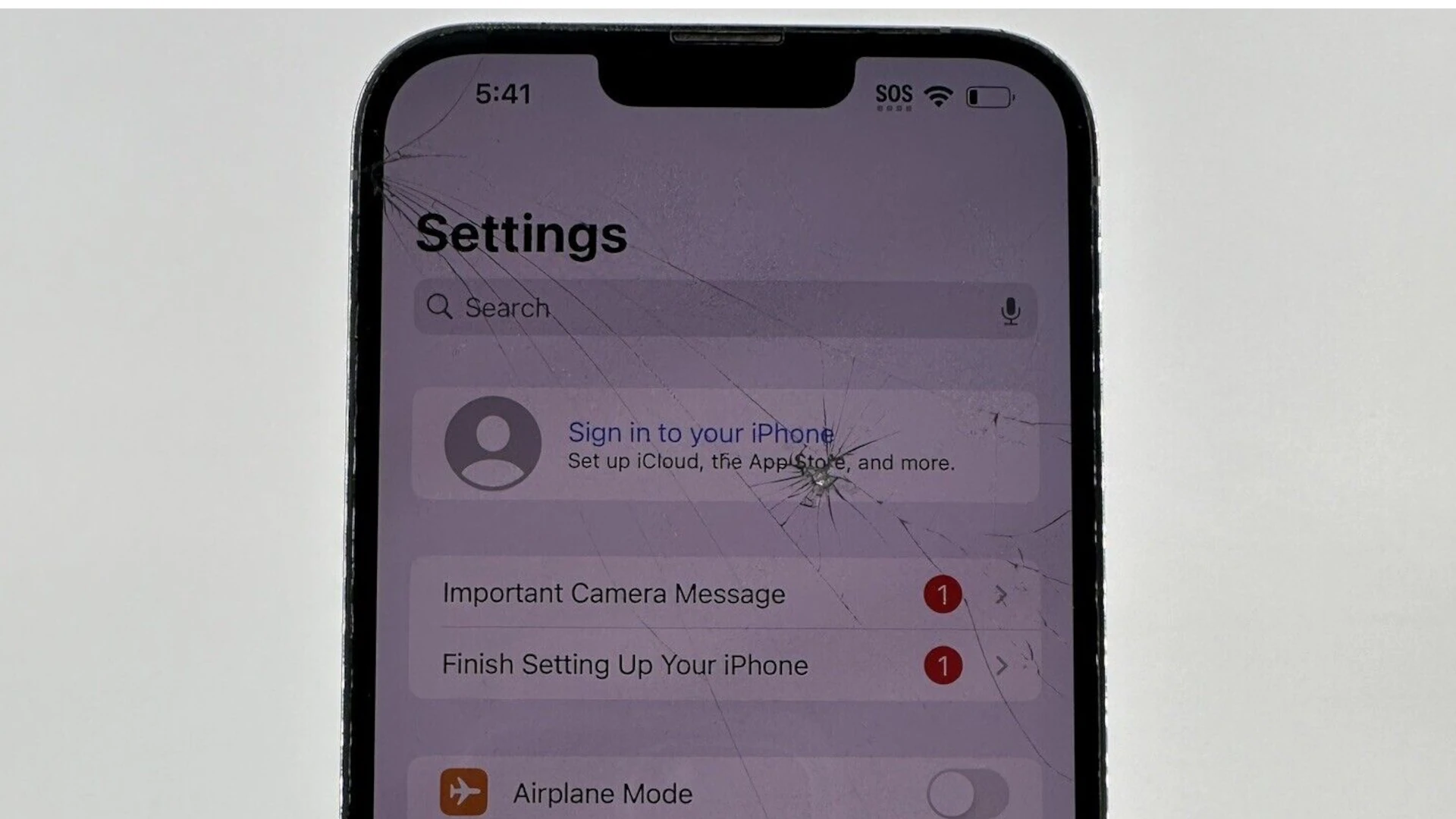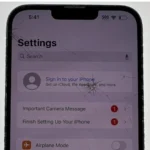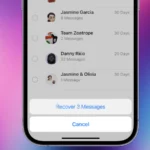Breaking your iPhone screen is a frustrating experience that happens to many of us. One second your phone is safe in your hand, and the next it’s face-down on the concrete with a spiderweb of cracks across the display. Don’t panic! You can get your iPhone screen fixed through Apple’s repair service, at third-party repair shops like Best Buy, or even attempt a DIY repair depending on your comfort level and the extent of the damage.
When your iPhone screen cracks, it’s important to first assess the damage. Small surface cracks might be manageable temporarily with a screen protector, while deeper breaks that affect touch functionality need immediate attention. If your phone is still under warranty or covered by AppleCare+, you may qualify for reduced-cost repairs directly through Apple.
For those looking to save money, there are DIY repair options available, though these require steady hands and the right tools. Third-party repair shops often offer faster service than Apple at competitive prices. Just remember that non-Apple repairs may void any remaining warranty on your device.
How to Fix a Cracked or Broken iPhone Screen
A cracked iPhone screen can be frustrating—and potentially dangerous if glass shards are loose. Depending on the severity of the damage, you can either repair it yourself, get it replaced by Apple, or use a trusted third-party service.
This guide walks you through what to do right after the damage, your repair options, and DIY replacement tips.
🧩 1. Assess the Damage
Before taking action, determine how bad the screen damage is:
- Minor scratches or hairline cracks: Usually cosmetic and don’t affect touch or display.
- Deep cracks or shattered glass: May affect touch sensitivity or visibility.
- Black spots, flickering, or no display: The LCD or OLED panel underneath is damaged.
If glass shards are sticking out, avoid touching the screen directly—use a case or screen protector temporarily to prevent injury.
(source: Asurion)
🔒 2. Back Up Your iPhone Immediately
Before any repair attempt, back up your data in case the device becomes unusable.
Options:
- iCloud:
Go to Settings → [Your Name] → iCloud → iCloud Backup → Back Up Now - Computer:
Use Finder (Mac) or iTunes (Windows) to create a local backup.
🧰 3. Official Apple Repair Options
If your iPhone is still under warranty or AppleCare+, this is usually the safest route.
Apple Repair Options:
| Option | Description | Estimated Cost (USD) |
|---|---|---|
| AppleCare+ | Covers up to two incidents of accidental damage | $29–$99 per repair |
| Out-of-warranty service | Standard Apple repair without AppleCare+ | $129–$379 depending on model |
| Apple Authorized Service Provider (AASP) | Certified repair centers using genuine parts | Similar to Apple Store pricing |
You can schedule a repair via the Apple Support app or Apple’s repair page.
(source: Geekschalk)
🧑🔧 4. Third-Party Repair Services
If your warranty has expired, consider certified third-party repair shops like:
- uBreakiFix / Asurion Tech Repair
- Simply Mac
- Best Buy (Apple Authorized)
- Local repair specialists with good reviews
These can often replace screens for 20–40% less than Apple’s out-of-warranty rates.
Just ensure they use OEM or high-quality replacement parts.
(source: SimplyMac)
🪛 5. DIY Screen Replacement (Advanced)
If you’re comfortable with small electronics repairs, you can replace the screen yourself—this can save money but voids your warranty.
You’ll Need:
- Replacement screen (OEM-quality recommended)
- Small Phillips and pentalobe screwdrivers
- Plastic opening tools or spudger
- Suction cup
- Tweezers
- Heat source (hair dryer or heat pad)
Steps Overview:
- Power off your iPhone.
- Remove the pentalobe screws near the Lightning port.
- Use a suction cup to lift the screen slightly, then insert a plastic tool to separate the display from the frame.
- Disconnect the battery before unplugging display cables.
- Remove and transfer components (front camera, sensors, home button, etc.) to the new screen.
- Reconnect everything, test the display, then reassemble.
(source: iFixit iPhone Screen Repair Guide)
⚠️ Note: DIY repairs require patience and precision. If you damage internal components or cables, the repair may cost more in the long run.
🧼 6. Temporary Fixes (If You Can’t Repair Immediately)
If you can’t repair your phone right away:
- Apply a tempered glass screen protector to prevent further cracking.
- Use clear packing tape as a short-term cover.
- Avoid moisture exposure—cracks can let water in.
- Use a sturdy case to prevent additional damage.
🧠 7. Prevent Future Screen Damage
- Always use a tempered glass screen protector.
- Choose a shock-absorbing case with raised edges.
- Avoid putting your phone in pockets with keys or coins.
- Be cautious when charging or using your phone on uneven surfaces.
✅ Summary
| Situation | Best Solution |
|---|---|
| Minor cracks, screen still works | Apply protector or case |
| Severe cracks, display issues | Professional repair or replacement |
| Under AppleCare+ | Schedule Apple repair for $29–$99 |
| Out of warranty | Use third-party or DIY replacement |
| No time for repair | Use temporary protection and back up data |
Final Tip:
If your iPhone is older (e.g., iPhone X or earlier), compare repair costs vs. trade-in value—sometimes upgrading to a new model is more cost-effective than replacing the screen.
Key Takeaways
- Apple offers official screen repairs with warranty coverage options, while third-party shops like Best Buy provide alternative repair services.
- Assess screen damage carefully before deciding between DIY fixes for minor cracks or professional repairs for serious breaks.
- Protect your iPhone with a quality case and screen protector after repairs to prevent future damage and additional repair costs.
Understanding iPhone Screen Damage
When your iPhone screen breaks, knowing what kind of damage you’re dealing with helps you make better repair decisions. Screen damage varies in type and severity, affecting both how your phone works and what repair options make sense.
Types of Screen Damage
iPhone screens typically experience several common types of damage:
- Hairline cracks: Thin, sometimes barely visible lines that may not affect touch functionality
- Spider web cracks: Multiple cracks spreading from a central impact point
- Shattered glass: Severe damage with loose glass pieces that pose safety risks
- LCD damage: Dark spots, discoloration, or black areas indicating damage beneath the glass
- Touch sensitivity issues: Areas of the screen that no longer respond to touch
Some damage only affects appearance, while other types can make your phone hard or impossible to use. Cracked iPhone screens often worsen over time if not fixed.
Even small cracks create entry points for dust and moisture. This can lead to bigger problems with your device’s internal components.
Assessing the Severity of a Cracked or Broken Screen
Before seeking repairs for your broken iPhone screen, take time to check how bad the damage really is:
- Test functionality: Can you still use all parts of the screen? Do all touches register correctly?
- Check for sharp edges: Rough or loose glass can cut fingers and cause further damage
- Look for display issues: Flickering, discoloration, or black spots mean deeper damage
- Assess spread risk: Small cracks often grow larger with continued use
Take photos of the damage for insurance claims or repair consultations. Back up your data immediately if your screen is severely damaged.
The extent of damage directly affects repair costs and options. Minor cracks might be manageable with a screen protector temporarily, but significant damage needs professional repair to prevent further issues.
Warranty and AppleCare+ Coverage
Understanding your iPhone screen repair coverage options can save you money and stress when accidents happen. Apple offers different levels of protection for broken screens depending on your coverage plan.
What Is Covered Under Warranty
The standard Apple warranty that comes with every iPhone does not cover accidental damage to screens. This means if you drop your phone and crack the screen, the standard warranty won’t help you.
Screen repairs are considered accidental damage, which falls outside the basic warranty protection. The standard warranty only covers manufacturing defects that happen during normal use.
If your screen has minor scratches, Apple typically considers this normal wear and tear. According to user experiences, heavily scratched screens are usually classified as cosmetic damage and aren’t covered even with AppleCare+.
You’ll need to pay the full repair cost if you only have the standard warranty and your screen breaks.
Benefits of AppleCare+ for Screen Repair
AppleCare+ significantly reduces screen repair costs. This extended protection plan covers up to two incidents of accidental damage every 12 months.
With AppleCare+, cracked screens are eligible for repair with a service fee that’s much lower than the standard out-of-warranty cost. The current service fee for screen damage with AppleCare+ ranges from $29-$49 depending on your iPhone model.
AppleCare+ must be purchased within 60 days of buying your iPhone. The plan extends your coverage to two or three years, depending on the plan you choose.
Even with a small crack on the screen, AppleCare+ coverage applies. This makes it worthwhile for many users who are prone to dropping their phones.
For frequent travelers, AppleCare+ offers additional peace of mind as it provides repair services worldwide, not just in your home country.
Options for iPhone Screen Repair
When your iPhone screen cracks, you have several trusted repair options that vary in cost, convenience, and service time. Each option comes with different benefits depending on your warranty status and how quickly you need your phone back.
Apple Store Screen Replacement Service
The Apple Store offers official screen replacement services with genuine Apple parts. Prices vary based on your iPhone model and warranty coverage.
If you have AppleCare+, screen repairs cost much less—typically around $29 for covered damage. Without AppleCare+, repairs can range from $129 to $379 depending on your iPhone model.
Many Apple Stores provide same-day service if you make an appointment through the Apple Support website or app. This is especially helpful when you need your phone fixed quickly.
The main benefits of choosing Apple for repairs include:
- Genuine Apple parts
- Factory-trained technicians
- Maintained warranty
- Water resistance preservation
Your repair is also backed by Apple’s service warranty, giving you peace of mind that the work meets high quality standards.
Authorized Third-Party Repair Shops
Third-party repair shops like Best Buy offer authorized repair services that may be more convenient than visiting an Apple Store. These shops use genuine Apple parts and follow Apple’s repair guidelines.
Many authorized repair centers offer same-day iPhone screen replacement services. Prices at these locations are often similar to Apple’s official pricing.
The advantages include:
- More locations than Apple Stores
- Sometimes shorter wait times
- Maintained warranty coverage
- Genuine parts
Best Buy and other authorized providers can handle most common screen repairs while keeping your warranty intact. This makes them a good option if there’s no Apple Store nearby.
Mail-In Repair Options
If you don’t need your phone fixed immediately, mail-in repair services offer a convenient alternative. Apple provides an official mail-in service where you ship your device to their repair center.
The process typically works like this:
- Request service online
- Receive a shipping box from Apple
- Send your iPhone to the repair center
- Get your fixed phone back in 3-5 business days
The cost for mail-in repairs matches in-store pricing, but you’ll need to factor in the time without your phone.
Some third-party companies also offer mail-in repairs, often at lower prices. However, using non-authorized services may void your warranty and might not guarantee genuine parts.
Mail-in options work well if you have a backup phone to use while waiting for your repair to be completed.
Do-It-Yourself Fixes
Fixing your iPhone screen at home can save money but comes with risks. Many people try DIY repairs when faced with repair costs that can range from $150-$400 at official stores.
Assessing the Risks of DIY Screen Repair
DIY screen repair isn’t for everyone. Without proper experience, you might damage your iPhone further or void its warranty.
Apple products use specific components that require careful handling. Attempting repairs yourself could lead to problems with touch sensitivity or display quality.
Before starting, consider:
- Your technical skill level
- The value of your device
- Warranty status (DIY repairs void Apple warranties)
- Time investment required
Many repair professionals recommend against DIY fixes for newer iPhone models with complex designs. The risk of permanent damage is higher with premium devices like the iPhone 12 or 14 Pro Max.
Required Tools for DIY Screen Repair
To replace an iPhone screen properly, you’ll need specialized tools. Most DIY repair kits include these essentials:
- Suction cup to lift the screen
- Small Phillips and pentalobe screwdrivers
- Plastic opening tools (to avoid scratching components)
- Tweezers for handling small parts
- Replacement screen (ensure compatibility with your model)
- Heat gun or hairdryer (to soften adhesive)
- Anti-static wrist strap to prevent damage to electronics
Quality tools make a big difference in repair success. Cheap screens often have touch issues or poor color quality compared to original parts.
Step-by-Step Guide to DIY Screen Replacement
Before starting, back up your iPhone and power it off completely. Work in a clean, well-lit area with organized space for small parts.
Remove the screen: Apply a suction cup to the bottom of the screen and gently pull upward while using a plastic tool to separate the edges.
Disconnect battery: Locate and disconnect the battery connector to prevent shorts.
Detach display cables: Carefully remove the small screws securing the display cables and disconnect them.
Transfer components: Move parts like the front camera, earpiece, and home button to the new screen.
Reconnect and test: Attach the display cables first, then the battery. Test the screen before sealing everything.
Secure the new screen: Press firmly around all edges to seal the adhesive.
Video tutorials can help guide you through model-specific steps.
Cost Analysis of iPhone Screen Repair
Repairing a cracked iPhone screen varies greatly in price depending on where you get it fixed and what model you own. Understanding these costs can help you make the best decision for your wallet.
Comparing Repair Costs: Apple Store vs Third Party vs DIY
Apple Store repairs are typically the most expensive option but offer guaranteed quality. For newer models like iPhone 13 or 14, Apple charges between $229 and $329 without AppleCare+. With AppleCare+, screen repairs cost much less – around $29.
Third-party repair shops usually charge 30-50% less than Apple. These shops can be a good middle ground between price and quality. Make sure to check reviews before choosing a shop.
The DIY approach costs the least. Screen repair kits from iFixit average about $81 for iPhone 11 models and older. However, this option requires technical skills and patience.
Cost Comparison Table:
| Repair Option | Average Cost | Pros | Cons |
|---|---|---|---|
| Apple Store | $169-$329 | Official parts, warranty | Most expensive |
| Third Party | $100-$200 | Lower cost, faster service | Variable quality |
| DIY Kit | $50-$100 | Cheapest option | Risk of further damage |
Hidden Costs to Consider in Screen Repair
Beyond the basic repair fee, several hidden costs may surprise you. If your iPhone has other damage, the repair shop might charge extra to fix those issues too.
Water damage often increases repair costs significantly. Many repair shops won’t even attempt screen replacement until water damage is addressed.
The quality of replacement parts affects long-term costs. Cheaper screens often break more easily, leading to repeat repairs. They may also drain your battery faster or have touch response issues.
Time is another hidden cost. Apple Store repairs might require appointments and longer wait times. Third-party shops are usually faster but might use lower-quality parts.
Warranty considerations matter too. Apple repairs maintain your warranty, while third-party repairs might void it. This could cost you more if other problems arise later.
Protecting Your iPhone Screen Post-Repair
After fixing your screen, taking steps to prevent future damage saves you money and frustration. Proper protection extends the life of your repair and keeps your iPhone looking great.
Best Practices to Prevent Future Damage
Always handle your iPhone with clean, dry hands to prevent dirt and moisture damage. Use a dedicated phone pocket separate from keys, coins, and other hard objects that can scratch the screen.
Consider investing in a sturdy case with raised edges around the screen. These protective borders prevent the screen from making direct contact with surfaces when placed face-down.
Be careful where you set your phone down. Avoid rough or uneven surfaces that might scratch the glass. Never place your phone on hot surfaces like car dashboards in summer.
Develop a habit of checking your pocket or bag before sitting down. Many screen cracks happen when phones are sat on or compressed against other objects.
Selecting the Right Screen Protector
Glass vs. Film Protection:
- Tempered glass: Provides best impact protection, feels like original screen
- PET film: Thinner, less expensive, minimal protection
- TPU film: Flexible, self-healing for minor scratches
Look for screen protectors with oleophobic coatings that resist fingerprints and make cleaning easier. Check that your chosen protector has precise cutouts for the front camera and sensors.
Many quality protectors include installation kits with alignment frames. These tools help ensure perfect placement without bubbles or dust. Some Apple-certified repair shops offer professional installation services for screen protectors.
Replace your screen protector immediately if it cracks or chips. A damaged protector can’t provide adequate protection and might even scratch your actual screen.
Troubleshooting Post-Repair Issues
After getting your iPhone screen replaced, you might face some unexpected problems. Knowing how to identify and fix these issues can save you time and extra repair costs.
Identifying Common Issues After Screen Replacement
New iPhone screens sometimes cause problems even after professional repairs. The most common issues include touch sensitivity problems, discoloration, and screen flickering.
Touch sensitivity issues often show up as unresponsive areas or “ghost touches” where the screen responds without being touched. To fix this, try restarting your iPhone and making sure the screen is clean.
Discoloration usually appears as yellow tints or dark spots. This might mean a lower quality replacement screen was used. Sometimes this fixes itself after a few days, but if not, return to your repair shop.
Screen flickering can happen with loose connections. Try these quick fixes:
- Restart your iPhone
- Check for iOS updates
- Reset all settings (Settings > General > Reset)
- Make sure the screen connector is properly seated
Using iOS Recovery Mode to Resolve Screen-Related Problems
Recovery mode can help fix software issues that affect your new screen. Put your iPhone in recovery mode when the screen freezes or shows only a black screen after replacement.
To enter recovery mode on newer iPhones (8 or later):
- Press and quickly release the volume up button
- Press and quickly release the volume down button
- Hold the side button until you see the recovery mode screen
For older models, the process differs slightly. Once in recovery mode, you can choose to update iOS, which often fixes screen-related software problems without erasing data.
If the screen still has issues after using recovery mode, try restoring your iPhone through iTunes or Finder. This resets the device completely, which often resolves stubborn software glitches affecting screen performance.
Model-Specific Considerations
Different iPhone models have unique requirements when it comes to screen replacement. The components, tools, and procedures vary between models, affecting both repair difficulty and cost.
Screen Repair for iPhone 6: What to Know
The iPhone 6 features a 4.7-inch display that’s relatively straightforward to replace compared to newer models. When dealing with an iPhone 6 screen repair, you’ll need to be careful with the home button, as it contains the Touch ID sensor.
Apple can repair your iPhone 6 screen, but it might be costly without AppleCare+. Third-party repair shops often offer more affordable options.
Tools needed for DIY repair:
- Precision screwdriver set
- Plastic prying tools
- Suction cup
- Tweezers
The ribbon cables connecting the screen are fragile. Handle them with extreme care to avoid further damage. Always power off the device completely before attempting any repair.
Handling iPhone 7 Screen Repairs Differently
The iPhone 7 introduced water resistance, making screen replacement more complex. The adhesive seal must be carefully removed and later replaced to maintain water protection.
Unlike the iPhone 6, the iPhone 7 has a solid-state home button that doesn’t physically click. This button is connected to the logic board, not the screen, which simplifies some aspects of repair.
iPhone 7 screens cost slightly more than iPhone 6 replacements. The replacement process requires additional steps:
- Removing the display assembly screws
- Disconnecting the home button cable
- Separating the front camera and sensor assembly
Always back up your data before beginning any screen repair on an iPhone 7. This protects your information in case something goes wrong.
Frequently Asked Questions
iPhone screen damage happens to many users. Here are answers to common questions about fixing cracked screens based on cost, methods, and service options.
What is the process for replacing a cracked iPhone screen at home?
Replacing an iPhone screen at home requires careful handling and the right tools. First, back up your iPhone data to prevent any loss during the repair process.
Purchase a quality replacement screen kit that includes the screen, tools, and instructions. These kits typically cost between $20-$100 depending on your iPhone model.
Turn off your iPhone and remove the screws at the bottom. Carefully lift the screen using a suction cup, disconnect the cables, and replace with the new screen. However, DIY repairs risk causing further damage to your device and may void your warranty.
How can I find a reliable iPhone screen repair service nearby?
Start by checking Apple’s official website for Apple Store locations or authorized service providers in your area. These offer guaranteed parts and warranty protection.
Use search engines with terms like “iPhone repair near me” and read customer reviews. Look for shops with high ratings, fair prices, and quick turnaround times.
Ask friends or family for personal recommendations. Someone you trust who had a good repair experience can point you to a reliable service.
What is the typical cost range for repairing a cracked iPhone screen?
The cost varies based on your iPhone model and where you get it fixed. At Apple Stores, screen repairs range from $129 for older models to $379 for newer Pro Max versions.
Third-party repair shops typically charge 30-50% less than Apple, with prices ranging from $80-$250 depending on your model and location.
If you have AppleCare+, screen damage repair costs only $29 for most models, making it much more affordable than standard repair pricing.
Is it possible to repair a cracked back cover on an iPhone, and what are the associated costs?
Yes, cracked back glass can be repaired, but the process is different from screen repairs. Apple treats back glass damage differently and often classifies it as “other damage.”
For newer iPhones without AppleCare+, back glass repair at Apple can cost between $349-$599, depending on your model. This is because the back glass is fused to the frame.
Third-party shops offer back glass repairs for $100-$300, but quality varies. Some use laser machines to precisely remove damaged glass without harming internal components.
Can you outline the steps involved in an iPhone 11 or iPhone 15 screen replacement?
For iPhone 11 screen replacement, technicians first disconnect the battery. They remove display screws, carefully disconnect display cables, and transfer components like the front camera to the new screen.
The iPhone 15 process is more complex due to its design. Technicians must work around Face ID components and handle fragile flexible cables with extra care.
Both repairs require calibration after replacement to ensure touch sensitivity and display color accuracy. Professional tools help ensure proper alignment and sealing of the new screen.
What factors influence the price of iPhone screen repair services?
The iPhone model greatly affects repair costs. Newer models like the iPhone 15 Pro Max have more expensive parts than older models like the iPhone 11.
Your location impacts pricing as well. Repair shops in major cities often charge more than those in smaller towns due to higher operating costs and competition.
The quality of replacement parts makes a big difference. Original Apple parts cost more than aftermarket alternatives but offer better performance and compatibility. Apple-certified repairs maintain your warranty and ensure proper function.







